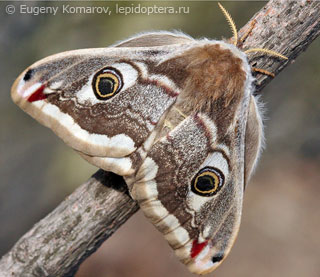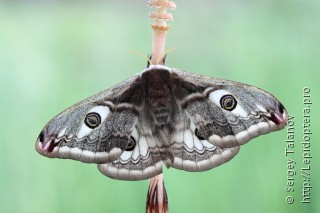Saturnia pavonia

Taxonomy
class Insecta
Species name(s)
Saturnia (Eudia) pavonia (Linnaeus, 1758) = Eudia pavonia (Linnaeus, 1758) = Phalaena pavonia Linnaeus, 1758 = minor Linnaeus, 1758 = Bombyx carpini Denis & Schiffermüller, 1775 = alpina Favre, 1897 = borealis Rangnow, 1935 = lapponica Lingonblad, 1936 = lappmarchica Bryk, 1948. [3, 9, 10]
Emperor Moth.
urn:lsid:insecta.pro:taxonomy:2812
Expansion
This species marks on the maps: 6.
Zoogeographical regions
Palaearctic.
Russia regions
#1. Kaliningradsky*; #2. Kolsky; #3. Karelsky; #4. Evropeisky Severo-Zapadny; #6. Evropeisky Severo-Vostochny; #7. Evropeisky yuzhno-tayozhny; #8. Evropeisky Tsentralny; #9. Evropeisky Tsentralno-Chernozyomny; #10. Sredne-Volzhsky; #11. Volgo-Donsky; #13. Zapadno-Kavkazsky; #14. Vostochno-Kavkazsky*; #15. Severo-Uralsky; #16. Sredne-Uralsky; #17. Yuzhno-Uralsky; #19. Sredneobsky; #20. Yuzhno-Zapadnosibirsky; #22. Krasnoyarsky; #23. Predaltaisky; #24. Gorno-Altaisky; #25. Tuvinsky*; #26. Predbaikalsky; #27. Pribaikalsky; #28. Zabaikalsky; #31. Yuzhno-Yakutsky; #36. Sredne-Amursky; #37. Nizhne-Amursky; #40. Primorsky.
* An asterisk denotes a region for which the species is listed as an migrant or information that requires additional checking.
Forewing length
20—35 mm.
Wingspan
50—75 mm.
Primary colors
Brown/Gray/Black, White.
Flight time
| January | February | March | April | May | June | July | August | September | October | November | December |
Larva lifespan
| January | February | March | April | May | June | July | August | September | October | November | December |
Over-wintering stage
Pupa.
Detailed information with references
Taxonomy, synonyms and combinations
Distribution
Imago Habitus and Differences from alike species
General info about Imago
Imago lifespan
General info about Larva
Larva food plants / other food objects
Larva lifespan
Egg
Overwintering stage
Subspecies of Saturnia pavonia
- Saturnia pavonia alpina Favre., 1897. [187]
- S. p. borealis Rangnow, 1935. [187]
- S. p. castiliana Watson. [187]
- S. p. josephinae (Schawerda, 1924). [10]
- S. p. josephinae Schawerda, 1923. [187]
- S. p. ligurica Weismann, 1876. [9]
- S. p. meridionalis Calberla, 1884-1888. [187]
- S. p. pavonia (Linnaeus, 1758). [10]
- S. p. valcarceli Agenjo, 1970. [187]
Authors
Initial species uploading to the site: Peter Khramov.
Text data: Peter Khramov.
The species characteristics formalization: Peter Khramov, Sergei Kotov, Vasiliy Feoktistov.
References
- [1] O. Karsholt, J. Razowski (eds.), 1996. The Lepidoptera of Europe: a distributional checklist
- [3] Каталог чешуекрылых (Lepidoptera) России. Под ред. С. Ю. Синёва. СПб.; М.: Товарищество научных изданий КМК, 2008
- [5] Райххолф-Рим Х. Бабочки. М.: Астрель, 2002
- [9] Tree of Life (funet.fi), 2012
- [10] de Jong, Y.S.D.M. (ed.) (2011) Fauna Europaea version 2.4 (faunaeur.org)
- [28] Moths and Butterflies of Europe and North Africa (leps.it), 2012
- [187] Species 2000, http://www.sp2000.org
Comments
Note: you should have a Insecta.pro account to upload new topics and comments. Please, create an account or log in to add comments
Saturnia pavonia photos














































































All the photos of the species in large size
Please, create an account or log in to upload your photo










